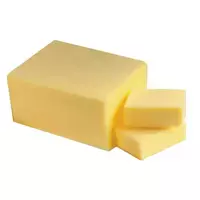Plant-fat spread

The vegetable-fat spread is a type of food products containing mixtures of fats, both of vegetable and animal origin. As a rule, milk fat, as well as the vegetable type of the product, are used to prepare the vegetable-fat spread. It is worth noting that according to standards, the amount of fats contained in the chemical composition of the spread should not exceed 95%.
Notably, the plant-fat spray was invented as an alternative to butter. Moreover, the main feature of the spread is the relative ease of smearing even the cooled product. The spread got its original name from the English verb spread, then literally means "smearing. "
In addition to vegetable and animal fats, the spread usually includes some butter. Such a product as a vegetable-fat spread belongs to the group of highly nutritious and high-calorie. On average, the calorie content of 100 grams of the spread is approximately 360 Kcal. It is worth emphasizing that in its chemical composition the spread of vegetable-fatty is similar to table margarine.
The composition of a high-quality spread of vegetable-fat should practically not contain fat of animal origin. The basis for the production of the spread can be vegetable oil obtained from soybeans and sunflower seeds. It is believed that animal fat substitutes are best suited for the production of the spread, since their chemical composition does not contain so-called trans fats that are harmful to the human body.
The vegetable-fat spread differs from butter primarily in its composition, and then in its taste and consumer characteristics. It is worth noting that in comparison with ordinary butter, the vegetable-fat spread differs in its lower cholesterol content. In addition, during the manufacturing process, food manufacturers necessarily saturate the spread with phytosterols, as well as vitamins of group A, as well as D.
The vitamin-mineral composition of the plant-fatty spread is dominated by monounsaturated as well as polyunsaturated fatty acids. These compounds play an important role in the vital activity of the human body. In butter, on the contrary, the content of saturated fatty acids is high. Interestingly, the World Health Organization has recommended minimizing saturated fatty acid intake.
As a result of a number of scientific studies, it was found that saturated fatty acids in large quantities lead to the development of serious diseases of the cardiovascular system of the human body. Therefore, on the one hand, spreads can be considered safer products than butter.
However, do not be mistaken and consider spreads a panacea and a healthy replacement for butter. Often, spreads contain various dietary supplements, which also in high concentrations when ingested in the human body can provoke the occurrence and development of various diseases.
spread plant-fat 360 kCal
The energy value of the plant-fat spread (Ratio of proteins, fats, carbohydrates - ju):
Proteins: 0 g (~ 0 kCal)
Fats: 40g (~ 360 kCal)
Carbohydrates: 0 g (~ 0 kCal)
Energy ratio (b | y): 0% | 100% | 0%
 Español
Español Français
Français Português
Português Русский
Русский 简体中文
简体中文 繁體中文
繁體中文 日本語
日本語 한국어
한국어 العربية
العربية Türkçe
Türkçe Қазақ
Қазақ Deutsch
Deutsch Italiano
Italiano Українська
Українська
